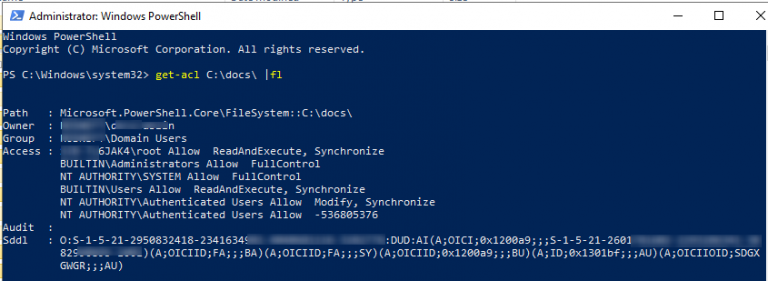

$Group = New-Object ("Builtin", "Administrators")

The next idea was to grab the ACL object of a folder elsewhere in the user’s home directory that had good permissions and then change the owner in that ACL object to ‘Builtin\Administrators” and the apply it to the profile folder.

Take Ownership using PowerShell and Set-ACL This was a huge issue and would not be acceptable with the customer. I still decided to press forward with this and later found the second issue: takeown.exe would not reliably grant ownership completely down the tree of subfolders. Obviously this is an issue if I expect to have this used as part of my project for others to take ownership on profiles which would more than likely have more items than my profile. I kicked it off on my own profile (because it is always more fun to test on yourself than others) and found that it would take upwards of 10 minutes vs. Sure it wasn’t a PowerShell approach, but it met the requirements of what I wanted to do…or so I thought. This was actually my initial idea as I allows for recursive actions and lets me specify to grant ownership to Builtin\Administrators. This created issues with deleting accounts and troubleshooting profile related issues.īefore showing the solution that I came up with, I will run down a list of attempts which never quite met my requirements and why. Also, ownership of those objects were by the user account. The brief background on this is that roaming profiles sometimes would become inaccessible to our support staff in that only the user account and System would have access to the profile folder and its sub-folders and files. But the goal was to come up with a command line solution that not only worked quickly, but didn’t miss out on a file or folder. Typically, one could use Explorer to find the folder and then take ownership and be done with it. TypeName: Īccess CodeProperty AccessĪccessToString ScriptProperty System.While working on a project recently, I needed to find an easy way to take ownership of a profile folder and its subfolders to allow our support staff to either delete the profile or be able to traverse the folder to help troubleshoot issues. PS C:\Users\proxb\Desktop> $ACL | Get-Member Let's take a look at the object and see if we can find a method that will help us change the owner. NET types to help with making the change of ownership from the SID to another user account.įirst thing that we need to do is get the current ACL object of the folder. Definitely nice, but I don't want to be limited to what account or group that can own the folder.
CHANGING OWNERSHIP OF A NETWORKVIEW OBJECT WINDOWS
We could use Windows Explorer to graphically locate the folder and view the properties and then set a new owner of the folder, but what fun is that? We also can make use of a utility called takeown.exe, which has a set of switches that can be used to set the owner of a folder and subfolders to either the current user or the built-in Administrators group. We can see that the Owner property is just a SID and means that we could have potential issues if something happened to the existing permissions on the folder. Path : \FileSystem::C:\Users\proxb\Desktop\Test


 0 kommentar(er)
0 kommentar(er)
